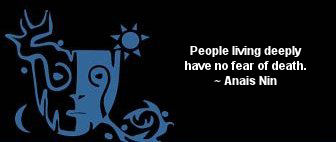|

Critical Mask
© 2007 by Maggy Anthony
[Image: "Gelede Society Mask" © Gene Anthony, used by permission
The first nuclear blast took place not in the deserts of New Mexico, but in the halls of the Paris Exposition of 1900. It was an explosion that tore through the fabric of Western Christian artistic sensibility that had its hold on the world for the past two thousand years.
The Ancient burst through layers of the collective unconscious, to imprint itself on the Modern; a blast that came about through a mask, or rather, a group of masks — African masks. The sight of them detonated in the mind of one young Spanish artist seven years later at the Musee d'Ethnographie, and, through him, changed the course of the modern imagination — Pablo Picasso.
From this encounter, from even this very moment, for he uses the word 'suddenly', he understands why he is a painter. The masks he is looking into, he realizes are magical. They possess real power. They are weapons to use against the dangers of life. 1.
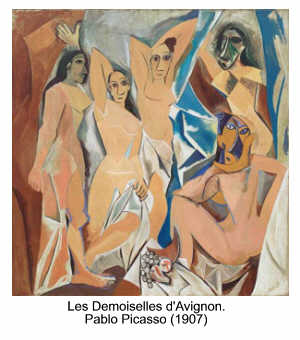 I've tried to find photographs or sketches of the specific masks that Picasso saw that day, but without success. A clue to what they looked like can perhaps be seen in "Les Demoiselles d'Avignon", painted in 1907 and foremost among the obvious fallout from the seminal event of the Expo. Two of the "demoiselles" are most obviously wearing masks where their faces would be, or perhaps those are their faces. The magic is there. I've tried to find photographs or sketches of the specific masks that Picasso saw that day, but without success. A clue to what they looked like can perhaps be seen in "Les Demoiselles d'Avignon", painted in 1907 and foremost among the obvious fallout from the seminal event of the Expo. Two of the "demoiselles" are most obviously wearing masks where their faces would be, or perhaps those are their faces. The magic is there.
"Years later, [Picasso] talked to Andre Malraux of the moment of conception. Les Demoiselles d'Avignon must have come to me that very day ... it was my first exorcism painting ... I understood what the Negroes used their sculpture for ... all ... were used for the same thing. They were weapons." 2.
What Picasso, Matisse, and all the young artists who viewed the masks could not even guess was that part of the power of them was that they were ancestor masks. Not just the ancestors of the black artisans who carved them, but the ancestors of all of us. So the masks caused reverberations that sounded deeply into the psyches of all who viewed them.
Now, one hundred years later, with our advancing knowledge of DNA, we know from whence the intensity of feeling came. Picasso was being moved by the deepest roots made visible. Indeed, the deepest roots of all of us: the African Eve as She has been named by geneticists.
Such a mask entered my life fifteen years ago in response to a statement I made during lunch with a new friend. I complained that I was up against a wall in my writing. That I had been stuck for a couple of years, and had begun to feel maybe I wasn't a writer at all; this despite having had a few books published, and one even a couple of years before. Then I was feeling full of things I wanted to write but simply could not get them down on paper. My new friend had an unusual suggestion. It seems that she had in her possession an African mask, very old, that had been given to her several years before. It was purported to be a fertility mask, and my friend said she could attest to this, as she and her husband had gotten pregnant three times in a row in short order. Finally she had taken it down from the wall and packed it away, as they had as many children now as they wanted. She offered it to me, as I was past child bearing age, and she suggested that perhaps the fertility attributed to it might transfer over to creativity.
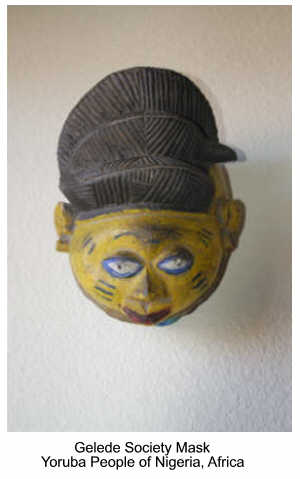 Once it came into my possession, the first thing that was different about this mask was that it seemed to have definite ideas of where it should be placed on my walls. I had tried placing it next to an abstract painting done by an artist friend of mine, but when I placed it there, I got a distinct "no" in my mind. I then tried to place it among other masks I had collected over the years, and again, a strong "no". When, a few months later, I mentioned this a little timidly to a very rational friend of mine, he told me matter-of-factly that he had a small pre-Columbian sculpture that hurled itself off wherever he put it if the surroundings were not congenial. This assured me somewhat that I was not losing my mind. Once it came into my possession, the first thing that was different about this mask was that it seemed to have definite ideas of where it should be placed on my walls. I had tried placing it next to an abstract painting done by an artist friend of mine, but when I placed it there, I got a distinct "no" in my mind. I then tried to place it among other masks I had collected over the years, and again, a strong "no". When, a few months later, I mentioned this a little timidly to a very rational friend of mine, he told me matter-of-factly that he had a small pre-Columbian sculpture that hurled itself off wherever he put it if the surroundings were not congenial. This assured me somewhat that I was not losing my mind.
My next assurance came when my daughter's dog came to stay with me, as he did every few weeks while she and her husband traveled. This dog, Auggie, was a mild mannered, golden retriever. When he came for the weekend shortly after I had put the mask up, he took one look and a ridge of fur stood along his spine; he bared his teeth, and began to bark ferociously at the mask. He had never barked at any of my other masks which were scattered on walls all over the apartment, some quite frightening looking. He was feeling the power and it alarmed him.
The real difference came within a two week period when I began to write poetry, something I had never done before. First there was an epic poem about the slave-crossings in ships, followed by an entire series with Dionysus as the center point. Since that time, now over fourteen years ago, I have followed up with non-fiction writings, and as of this date, five plays. Of course, I am aware of how powerful a thing projection is, but this feels different, and when I began to research the origins of the mask, it somehow made sense.
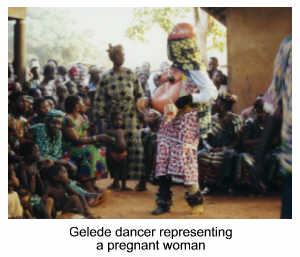 My mask is from the Gelede Society of the Yoruba peoples of Nigeria and surrounding countries. The society is made up of men who come into towns in ceremonial costume of cloth draped from the tops of their heads to their feet. The masks, of women, men, and animals, are set on top of their heads, and often these ceremonies are to renew the feeling of feminine power in the community. The Society was founded in honor of Yemaya, the powerful Mother Goddess worshipped by many tribes throughout Africa, and after the diaspora, by thousands in the New World where Her worship was carried into the religions of Santeria, Umbanda, Vodun, and a score of interrelated spiritualities into which the old African religions went underground, covering themselves out of necessity with Christian trappings. My mask is from the Gelede Society of the Yoruba peoples of Nigeria and surrounding countries. The society is made up of men who come into towns in ceremonial costume of cloth draped from the tops of their heads to their feet. The masks, of women, men, and animals, are set on top of their heads, and often these ceremonies are to renew the feeling of feminine power in the community. The Society was founded in honor of Yemaya, the powerful Mother Goddess worshipped by many tribes throughout Africa, and after the diaspora, by thousands in the New World where Her worship was carried into the religions of Santeria, Umbanda, Vodun, and a score of interrelated spiritualities into which the old African religions went underground, covering themselves out of necessity with Christian trappings.
She is perhaps one of the most fecund of Goddesses, the real, acknowledged creative power itself. Through this mask, which comes with me in every move I make, She has become not only my personal African Eve, my ancestress, but my personal critical mask.
References:
- Griffin, Susan, A Chorus of Stones
 , Doubleday Books, 1992, Pg. 213 , Doubleday Books, 1992, Pg. 213
- Stassinopoulos-Huffington, Arianna, Picasso Creator and Destroyer
 , Simon and Shuster, 1988, Pages.89-90. , Simon and Shuster, 1988, Pages.89-90.
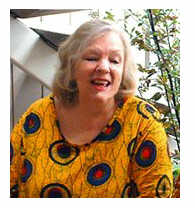 Maggy Anthony it the author of Jung's Circle of Women: The Valkyries (Jung on the Hudson Books) Maggy Anthony it the author of Jung's Circle of Women: The Valkyries (Jung on the Hudson Books) , Landscape of Desire , Landscape of Desire , and Impossibly Blonde: The Genesis of a Play in the Death and Funeral of Marilyn Monroe , and Impossibly Blonde: The Genesis of a Play in the Death and Funeral of Marilyn Monroe . She attended the Zurich Jung Institute in the 70s. Since then she has taught mythology, Jungian psychology and myth at places as diverse as Esalen Institute, and the Center for Living Well in Reno. . She attended the Zurich Jung Institute in the 70s. Since then she has taught mythology, Jungian psychology and myth at places as diverse as Esalen Institute, and the Center for Living Well in Reno.
"I received a minor initiation into Umbanda,while living in Rio de Janeiro for two years," said Anthony. "It was my introduction to Yemaya, named Iemanja in Brazil. I had been looking for a spiritual connection since I was eighteen, and when in Brazil, found it in the attachment to this Yoruba deity, who chose me during a ceremony where I had gone merely as a spectator. A fictionalization of this event occurs in one of the stories in my collection, Landscape of Desire. It has had a profound impact in my life, and when I came home from the Jung Institute years later, I taught the history and impact of the Goddess at Esalen Institute in San Francisco, then went on and tauight similar classes all over the Western United States in the late 70s, 80s and into the 90s."
Read more about Maggy Anthony at her website pahrahdiseonline.com
Return to Mythic Passages Menu
Subscribe to the Mythic Passages e-magazine
|
